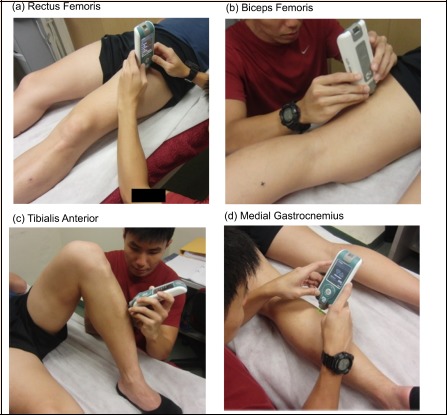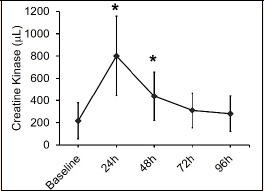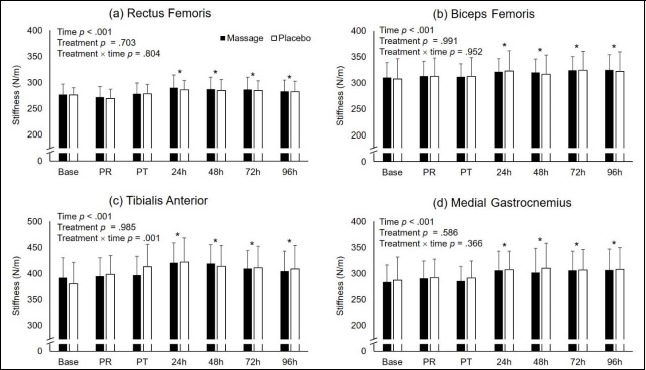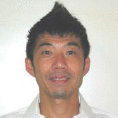Abstract
It is commonly believed that massage can reduce muscle stiffness and is desirable for recovery from exercise. However, the effect massage on muscle stiffness following eccentric exercises is currently unknown. This study aimed to examine the effect of post-exercise massage on passive muscle stiffness over a five-day period. A randomised cross-over study design was adopted. After 40 minutes of downhill running, 18 male recreational runners had one leg received a 16-minute massage and the contralateral leg received a 16-minute sham ultrasound treatment. Passive stiffness for four leg muscles (rectus femoris, biceps femoris, tibialis anterior, and gastrocnemius) was assessed using myotonometry at baseline, immediately post-run, post-treatment, 24, 48, 72, and 96 hours post-run. A 2 (treatment) × 7 (time) mixed ANOVA was conducted with a robust procedure on the myotonometry data of each leg muscle to examine the effect of treatment on stiffness. Passive stiffness for all muscles changed over time but no treatment effect was found. Stiffness increased at 24 hours post-run and remained elevated from baseline levels for up to 96 hours across all four muscles. Significant treatment × time interaction was only found in the tibialis anterior but no post-hoc differences were identified. Passive stiffness of major leg muscles increased after a bout of unaccustomed eccentric exercise and remained elevated for up to four days post-exercise. Compared with the placebo treatment, post-exercise massage had no beneficial effect in alleviating altered muscle stiffness in major leg muscles.
Key points.
Passive stiffness of major leg muscles increased after a bout of unaccustomed eccentric exercise and remained elevated for up to four days post-exercise.
Compared with the placebo treatment, post-exercise massage has no beneficial effect in alleviating altered muscle stiffness in major leg muscles.
Monitoring passive muscle stiffness using myotonometry may provide useful information for coaches and clinicians on the recovery status of athletes.
Key words: Eccentric, running, Myoton, soreness, pain, Swedish
Introduction
Massage is a common form of treatment practiced to help athletes recover from training- and competition-induced symptoms of delayed-onset muscle soreness (DOMS) and to enhance their subsequent sporting performance (Barnett, 2006; Galloway and Watt, 2004; Weerapong et al., 2005). It is estimated that massage contributes to approximately 45% of all treatments provided to elite athletes during sporting competitions (Galloway and Watt, 2004). Many coaches and athletes believe that massage can reduce muscle stiffness and is desirable for recovery and injury prevention. In the literature, elevated muscle stiffness has been shown to relate to injury incidence in elite athletes (Rodrigeuz et al., 2017) but only three studies have investigated the effect of massage on muscle stiffness in human participants (Eriksson Crommert et al., 2015; Ogai et al., 2008; Thomson et al., 2015). Following supramaximal cycling, a 10-minute petrissage massage improved the recovery of muscle stiffness in the quadriceps and enhanced subsequent cycling performance (Ogai et al., 2008). In contrast, no changes were found in passive calf muscle stiffness with or without a bout of 10-minute deep tissue massage (Thomson et al., 2015). Another study demonstrated that a 7-minute massage provided an immediate reduction in muscle stiffness of the medial gastrocnemius but this effect did not persist after a short 3-minute rest period (Eriksson Crommert et al., 2015). The authors hypothesized that massage breaks the stable cross-bridges between the myosin and actin filaments and that gradual reattachment of the filaments occur immediately after massage has ceased, accounting for the short-term reduction in muscle stiffness. These mixed results from previous studies urge the need to further examine the response in muscle stiffness following massage treatment.
It should be noted that previous investigations on muscle stiffness administered massage treatments either without any exercise protocol (Eriksson Crommert et al., 2015; Thomson et al., 2015) or involved only concentric muscle contraction (cycling) (Ogai et al., 2008). No studies have examined the effect of massage on muscle stiffness following eccentric exercises, which induces greater muscle soreness than concentric exercises (Clarkson et al., 1986). Also, previous studies only examined the immediate or short-term (i.e., up to 30 minutes) effects of massage and did not use a placebo treatment (Eriksson Crommert et al., 2015; Ogai et al., 2008; Thomson et al., 2015). Given the positive psychological effect of massage (Weerapong et al., 2005) and that exercise-induced symptoms of DOMS usually last for one to five days post-exercise (Armstrong, 1984; Clarkson, 1986), it is necessary to include a placebo treatment and to adopt a longer study duration to better understand the effects of massage on muscle stiffness.
Thus, the aim of this study was to examine the effect of post-exercise massage on passive muscle stiffness over a five-day period. It was hypothesized that massage would be more effective than a placebo treatment in alleviating altered muscle stiffness induced by an eccentric bout of exercise.
Methods
Participants
This study was approved by the Nanyang Technological Institutional Review Board (IRB-2014-10-054). The inclusion criteria were male, aged 18 to 35 years, and ran at least three times per week covering a weekly distance of at least 9 km for the past two months. The exclusion criteria included any history of surgery to the back or leg, serious injuries to the back or legs in the last six months, discomfort or pain in the back or legs, use of pain and anti-inflammatory medications, or any contraindications to massage treatment (allergy to oil or cream, skin infection, diabetes, or deep vein thrombosis). Eighteen healthy male recreational runners [mean (SD), age 24.9 (3.4) years, height 1.71 (0.05) m, body mass 63.5 (7.5) kg; 2.4 km run time, 8.96 (0.85) min] provided written informed consent to participate in the present study. This sample size was calculated based on a previous study (Eriksson Crommert et al., 2015), which showed a decrease in muscle stiffness following massage (moderate effect size = 0.25 for F tests, α = .05, β = .20).
Study design
A double-blind, within-participant study design was adopted. Participants had one leg randomly assigned to massage and the contralateral leg to a placebo treatment (Hilbert et al., 2003; Smith et al., 1994; Zainuddin et al., 2005). The study trials spanned over five consecutive days, including a main trial (exercise and treatment) and four follow-up tests (24, 48, 72, and 96 hours post-exercise). Participants had one familiarisation session which comprised a multi-stage treadmill test of level running at increasing speeds, and all muscle assessment procedures. To minimise bias towards the massage protocol, participants were given the impression that both limbs had undergone therapeutic treatments (massage or ultrasound).
The main trial commenced at least 48 hours after the familiarisation session. Participants were asked not to partake in any exercises or engage in any recovery aids 48 hours prior to main trial and throughout the five-day study period. Participants reported at 0800 h to the laboratory to have their muscle stiffness, perceived muscle soreness, and plasma creatine kinase (CK) measured (baseline). To induce muscle soreness, participants ran downhill for 40 minutes on a treadmill (Lode Katana Sports XL, Groningen, The Netherlands) at a gradient of -10°. This eccentric exercise protocol has been shown to successfully induce muscle soreness (Byrnes et al., 1985; Farr et al., 2002). The mean (SD) downhill running speed of 11.2 (1.4) km/h, corresponding to 80% of each participant’s maximal heart rate during level running, was pre-determined through the multi-stage treadmill run test conducted during the familiarisation session. The downhill run was followed by a 30-minute transition period to shower and get changed before a second set of stiffness and soreness measurements were taken (post-run). One-and-a-half hours after the run, participants received massage and placebo treatments for 32 minutes (16 minutes per leg) in a randomised order. Immediately after the treatments, muscle stiffness and soreness were assessed (post-treatment). Following main trial, participants returned for the next four consecutive mornings for follow-up measurements of muscle stiffness, perceived muscle soreness, and plasma CK (24, 48, 72, and 96 hours post-run).
Massage and placebo treatments
One qualified physiotherapist with 11 years of experience, who regularly performed massage in her clinical practice, delivered both the massage and placebo treatments throughout the study to ensure good consistency. One randomly selected leg of each participant received a 16-minute standardised massage routine targeting four areas: quadriceps, hamstrings, tibialis anterior, and gastrocnemius. Using unscented massage oil, each area was massaged for 4 minutes using typical Swedish techniques (2-min effleurage, 40-s wringing, 40-s kneading, and 40-s tapotement). The contralateral leg received a matching 16-minute (4 minutes for each targeted area) sham therapeutic ultrasound treatment with an inactive probe (0 MHz) and water-soluble ultrasound transmission gel (Aquasonic 100, New Jersey, USA), which had no therapeutic effect. The treatment orders were randomised and counter-balanced, with the same series of soothing music played during both treatments. For blinding purpose, the treatments were conducted in an enclosed room without the presence of the tester. At the end of the treatments, massage oil was applied to the leg which received sham treatment. With both limbs having the presence of oil, the assignment of treatments would not be apparent to the tester. Participants were reminded not to reveal their treatments (e.g., which leg received massage) to the tester throughout the five-day study period.
Muscle stiffness measurements
Passive muscle stiffness was measured in a relaxed state using a hand-held myotonometry device, the MyotonPRO (Myoton AS, Tallinn, Estonia), which applies a brief (15 ms) mechanical impulse to elicit damped oscillations of the muscle (Figure 1). Stiffness was determined from the oscillation response of the muscle registered by an in-built accelerometer (Frohick-Zwahlen et al., 2014; Janecki et al., 2011; Pruyn et al. 2016). Good construct, concurrent, and predictive validity of myotonometric measurements have been demonstrated in the literature (Chuang et al 2012; Gubler-Hanna et al., 2007; Pruyn et al. 2016). Excellent relative and absolute reliabilities have also been reported (Bizzini and Mannion, 2003; Chuang et al., 2013; Lam et al., 2015). When applied in sport, this method has been shown to successfully monitor changes in stiffness following eccentric exercises for up to five days (Janecki et al., 2011). Four muscle sites were selected for stiffness measurement: rectus femoris, biceps femoris, tibialis anterior, and medial gastrocnemius (Figure 1). At each site, the mean value of two sets of five consecutive measurements was used for analysis. To maintain good consistency across five days, the measurement points were marked on the skin with a permanent marker. The same tester took all stiffness measurements throughout; intra-rater reliability was excellent (intra-class correlation = 0.852 to 0.993 across four muscle sites).
Figure 1.

Muscle stiffness was measured using the MyotonPRO device on four muscle sites: (a) rectus femoris (mid-point between anterior superior iliac spine and top of patella), (b) biceps femoris (mid-point between ischial tuberosity and head of fibula), (c) tibialis anterior (one-third from head of fibula to medial malleolus, 2 cm away laterally from tibia), and (d) gastrocnemius (middle of the most prominent muscle bulge when participant tip-toed on one foot).
Perceived muscle soreness
Perceived muscle soreness was assessed using an 11-point numerical rating scale (NRS), where 0 represents “no soreness at all” and 10 indicates “the worst imaginable soreness” (Hjermstad et al., 2011). For each muscle site, participants were asked to rate their perceived soreness after stepping up and down from a 40-cm high box (Chen et al., 2007). To assess muscle soreness on the left side, participants stepped up using the left leg and back down using the same leg, with the process reversed for the right leg. This step-up-and-down protocol was done to induce sensations of soreness caused by DOMS (Lau et al., 2013), allowing the participants to have a better gauge of pain. The assessment orders of the muscle sites were randomly assigned for every trial to avoid any effect of anticipation.
Plasma Creatine Kinase (CK)
Plasma CK was determined through fingertip blood sampling to provide a biochemical marker of muscle damage. Capillary blood (approximately 100 μL) was drawn using a lancet (ACCU-CHEK Safe-T-Pro Plus, Indiana, USA) and collected through a microvette (Sarstedt Microvette 100 LH, Nümbrecht, Germany), of which 32 μL was pipetted onto a CK test strip (Reflotron CK, Mannheim, Germany). Analysis was done using a dry chemistry analyzer (Roche Reflotron Plus, Rotkreuz, Switzerland).
Statistical analysis
One-way repeated measures analysis of variance (ANOVA) was used to examine the change in CK across five days. A 2 (treatment) × 7 (time) mixed ANOVA using the R package of WRS2 (Mair and Wilcox, 2015) was conducted for each muscle site to examine the effects of treatments on muscle stiffness and perceived muscle soreness across the seven measurement time points. This is a robust method for conducting two-way mixed ANOVA, which can be considered non-parametric equivalence of mixed ANOVA (Field et al., 2012). In the analyses, significance for the main effect was set at p < 0.050. Post-hoc pairwise comparisons were applied using Bonferroni adjusted alpha levels where appropriate.
Results
There was a significant main effect of time for CK, indicating that the downhill running protocol was effective in inducing muscle damage (Figure 2). Compared with the baseline value (216.7 [95% confidence intervals, 133,6, 299.9] μL, CK level peaked 24 hours (Δ = 583.2 [434.5, 731.9] μL, p < 0.013 [.050/4]] after the eccentric downhill run and remained significantly elevated at 48 hours (Δ = 221.1 [133.8, 308.3] μL, p < 0.013), and gradually returned towards baseline value at 72 hours (Δ = 93.8 [16.5, 171.2] μL] and 96 hours (Δ = 63.3 [14.2, 112.4] μL).
Figure 2.

Plasma creatine kinase levels across five days. * indicates post-hoc difference from baseline with Bonferroni adjustments (p < 0.013 [.050/4]).
For the stiffness of all four muscles, there was a significant main effect of time (p < 0.001) but no treatment effect of treatment (Figure 3). Post-hoc analyses revealed similar patterns across all muscles that stiffness increased from baseline at 24 hours post-run and remained elevated from baseline levels for up to 96 hours after the eccentric downhill run (p < 0.008 [.050/6]). Significant treatment × time interaction was only found in the tibialis anterior (p < 0.001) but not the other three muscles. Post-hoc analyses, however, did not reveal any pairwise statistical difference between the massage and placebo conditions at any time point. It is notable from Figure 3 that at post-treatment, stiffness of the tibialis anterior that received massage was lower (396.8 [378.9, 414.7] N/m) than the placebo condition (412.3 [390.5, 434.0] N/m) but this difference (-15.5 [-32.9, 1.9] N/m, p = 0.071) did not reach statistical significance.
Figure 3.

Muscle stiffness measured using myotonometry across 5 days. * indicates post-hoc difference from baseline with Bonferroni adjustments (p < 0.008 [(.050/6]).
For perceived muscle soreness, there was a significant main effect of time (p < 0.001) for all muscles (Figure 4). Post-hoc pairwise comparisons with baseline indicated that muscle soreness for both legs increased after the downhill run and peaked at 24 hours post-run in all four muscles (p < 0.008[.050/6]). Soreness values were gradually reduced 48 hours post-run but remained significantly elevated against baseline values for all 96 hours post-run (p < 0.008). Significant treatment effect was observed only in the biceps femoris (p = 0.01), with a very small overall difference between the legs across five days (massage = 2.06 [1.33, 2.78], placebo = 2.17 [1.48, 2.87], mean difference = -0.12 [-0.26, 0.02] in a scale of 0 to10). No interaction effects were found in any muscles.
Figure 4.

Perceived muscle soreness measured using numerical rating scale (NRS) across five days. * indicates post-hoc difference from baseline with Bonferroni adjustments (p < 0.008 [(.050/6]).
Discussion
The present study examined the effect of post-exercise massage on passive muscle stiffness measured using myotonometry. With a placebo treatment and follow-up measurements over five days, this study allowed a better understanding of the long-term effect of massage on muscle stiffness after eccentric exercise. The main findings were that muscle stiffness increased after a bout of downhill run and remained elevated for up to four days post-exercise, but there was no difference between massage and placebo treatments in three out of four tested muscles. While there may be some beneficial effect for the tibialis anterior, overall there were no clear evidence to support our hypothesis that massage was more effective than the placebo treatment in alleviating altered muscle stiffness induced by a bout of unaccustomed eccentric exercise.
Change in muscle stiffness
Muscle stiffness measurements can offer insightful information for injury risk monitoring and prevention strategies, as a prospective study on elite netball players found higher stiffness in the soleus and Achilles tendon of injured compared with non-injured athletes (Rodrigeuz et al., 2017). In the present study, passive stiffness in all tested muscles consistently increased after a bout of downhill run and remained elevated for up to 4 days post-exercise. Our observation supports a previous study which measured the stiffness of an upper limb muscle following eccentric exercises using myotonometry (Janecki et al., 2011). In this earlier study, stiffness of the biceps brachii increased from 223(19) N/m to 254(22) N/m immediately after a protocol of repeatedly lowering a dumbbell, and high stiffness values lasted for up to five days. One notable difference from their findings is that in our study, muscle stiffness did not increase immediately after the exercise but only 24 hours later and this pattern was consistent among all four tested muscles (Figure 3). The discrepancy in the onset of increased stiffness may be related to participant characteristics and/or the muscle groups tested. Participants in the study by Janceki et al. (2011) were untrained individuals whose upper limb muscles were likely less exposed to eccentric contraction compared with the regular runners in our study whose lower limb muscles were more accustomed to absorb impact shock eccentrically during the ground contact phase of running. Other factors such as muscle thickness and subcutaneous thickness may also affect myotonometric readings (Frohick-Zwahlen et al., 2014). For the purpose of longitudinal tracking of an individual over time, it is evident that passive muscle stiffness measured using myotonometry is sensitive to changes induced by intense, eccentric exercises. Thus, monitoring passive muscle stiffness may provide useful information for coaches and clinicians on the recovery status of athletes.
Effects of massage
We originally hypothesised that massage would be more effective than the placebo in alleviating the altered muscle stiffness induced by eccentric exercises but our results did not provide clear evidence to support this hypothesis. Post-exercise massage did not provide a beneficial effect on muscle stiffness recovery over the placebo treatment in major leg muscles including the quadriceps, hamstring, and calf. Although no clear post-hoc differences can be found, massage may have some subtle effect on the tibialis anterior (Figure 3), a muscle that plays a primary role in controlling the foot motion during locomotion (Louwerens et al., 1995). One previous study found that massage reduced calf muscle stiffness immediately but the effect did not last after a 3-min rest (Eriksson Crommert et al., 2015). The authors postulated that massage induces some short-lived effect on the myosin and actin cross-bridges that is able to mitigate the immediate increase in stiffness seen post-exercise. With one bout of post-exercise massage, findings from the present study showed no difference in passive muscle stiffness between the massage and placebo conditions over 96 hours. Considering the potential short-term benefit of massage (Eriksson Crommert et al., 2015), it is worth exploring if there exists a cumulative effect of multiple massage treatments on muscle stiffness during recovery from exercises.
Previous studies on massage have found contrasting results of improved recovery of stiffness in the quadriceps (Ogai et al., 2008), no change (Thomson et al., 2015) or reduced muscle stiffness in the calf (Eriksson Crommert et al., 2015). Since these earlier studies only examined relatively short-term effects of massage (Eriksson Crommert et al., 2015; Ogai et al., 2008; Thomson et al., 2015), the present study provides new insight on how muscle stiffness responds to massage for up to four days post-exercise. From our findings, it is clear that there is no long-term benefit of a single session of post-exercise massage, when compared with placebo, on the recovery of elevated muscle stiffness in major leg muscles. We acknowledge that the Swedish massage techniques administered in the present study, though commonly practiced (Farr et al., 2002; Weerapong et al., 2005), may be too gentle to induce sufficient therapeutic effects. Using more intense technique which can be painful, one study showed that applying roller massage for a short duration (five sets of 20 to 60 s) could increase knee-joint range of motion and neuromuscular efficiency during a lunge (Bradbury-Squires et al., 2015). Future studies can investigate the effects of different massage techniques on muscle stiffness.
In parallel with the lack of long-term effect of massage on muscle stiffness, massage did not improve perceived muscle soreness as reflected by the lack of treatment by time interaction in NRS for all muscles (Figure 4). Although it is generally perceived that massage provides positive psychological effects (Cafarelli and Flint, 1992; Galloway and Watt, 2004; Weber et al., 1994), our findings support previous studies which have shown that massage was not effective in improving perceived muscle soreness (Dawson et al., 2011; Farr et al., 2002; Weber et al., 1994). The present study adopted a within-subject design in which one leg received massage and the other leg received a placebo treatment, expecting that the effects on massage on muscle stiffness are localised to the muscles that are being manipulated. For pain perception, however, rolling massage has been shown to demonstrate non-localized effect on the contralateral limb (Aboodarda et al., 2015). This suggests that central pain-modulatory system may play a role in the mediation of perceived pain following massage (Aboodarda et al., 2015) and hence explaining the lack of differences in perceived soreness between the massage and placebo limbs in the present study.
It is worth noting the different patterns of response for muscle stiffness and perceived muscle soreness during the recovery period. For all muscles, stiffness increased at 24 hours post-run and remained elevated from baseline levels until the end of the five-day trial. Perceived muscle soreness increased immediately after the run, peaked at 24 hours post-exercise, and gradually reduced in subsequent days. The lack of correspondence in the two patterns suggests different underlying mechanisms for post-exercise changes in muscle stiffness and perceived muscle soreness. Based on the present findings, post-exercise massage is unlikely to play a strong role in attenuating these responses.
Limitations
There are several limitations to the present study. First, we used an intensive eccentric protocol to induce substantial muscle damage in the participants. Massage may have different effects on muscle stiffness and perceived muscle soreness with exercise that is less damaging. Next, we did not measure how participants felt about the massage and placebo treatments. They might perceive both treatments positively, which might have influenced their perceived muscle soreness. In future studies, participant’s perception of different treatments should be measured and statistically controlled. Finally, we only examined lower limb muscles and recruited male participants who ran regularly. Caution should be taken when interpreting the results to other muscle groups and population.
Conclusion
Passive muscle stiffness measured using myotonometry increased after a bout of unaccustomed eccentric exercise and remained elevated for up to four days post-exercise in major leg muscles. Monitoring passive muscle stiffness using myotonometry may provide useful information for coaches and clinicians on the recovery status of athletes. During recovery, post-exercise massage was not more effective than the placebo treatment in alleviating the altered muscle stiffness in the quadriceps, hamstrings, and calf. For the tibialis anterior, there may be subtle beneficial effect of massage in attenuating the increase in muscle stiffness. When considering massage as a recovery strategy after training and competitions, coaches and athletes should be aware that massage is generally not effective in enhancing the recovery of stiffened muscles in the quadriceps, hamstrings, and calf.
Acknowledgements
The study protocol was approved by the Nanyang Techonological University Institutional Review Board (Protocol Number: IRB-2014-10-054).The experiments comply with the current laws of Singapore where they study was performed. The authors certify that they have no affiliations with or financial involvement in any organization or entity with a direct financial interest in the subject matter or materials discussed in the article. This study was funded by the Singapore Sports Science and Technology Research Grant (SSSTRG/SEPT2013/GC1-45). The funding source is not involved in the followings: study design; the collection, analysis and interpretation of data; in the writing of the report; and in the decision to submit the article for publication. We would like to acknowledge Ng Teng Fong General Hospital, Jurong Health for their help with treatment delivery.
Biographies

Pui Wah KONG
Employment
Associate Professor at the Physical Education and Sports Science Academic Group, National Institute of Education, Nanyang Technological University, Singapore.
Degree
PhD
Research interests
Sport and clinical biomechanics
E-mail: puiwah.kong@nie.edu.sg

YaoHui CHUA
Employment
Strength and conditioning coach at the Singapore Sports Institute, Sport Singapore.
Degree
MSc
Research interests
Sport biomechanics, strength and conditioning
E-mail: kelvinchuayh@gmail.com

Masato KAWABATA
Employment
Assistant Professor at the Physical Education and Sports Science Academic Group, National Institute of Education, Nanyang Technological University, Singapore.
Degree
PhD
Research interests
Sport and exercise psychology
E-mail: masato.kawabata@nie.edu.sg

Stephen F. BURNS
Employment
Associate Professor at the Physical Education and Sports Science Academic Group, National Institute of Education, Nanyang Technological University, Singapore.
Degree
PhD
Research interests
Exercise physiology, health
E-mail: stephen.burns@nie.edu.sg

Congcong CAI
Employment
Head and Senior Principal Physiotherapist at Ng Teng Fong General Hospital, JurongHealth, Singapore.
Degree
PhD
Research interests
Physiotherapy, biomechanics, low back pain
E-mail: cong_cong_cai@nuhs.edu.sg
References
- Aboodarda S.J., Spence A.J, Button D.C. (2015). Pain pressure threshold of a muscle tender spot increases following local and non-local rolling massage. BMC Musculoskeletal Disorder 16, 265. [DOI] [PMC free article] [PubMed] [Google Scholar]
- Armstrong R.B. (1984) Mechanisms of exercise-induced delayed onset muscular soreness: a brief review. Medicine and Science in Sports and Exercise 16(6), 529-538. [PubMed] [Google Scholar]
- Barnett A. (2006) Using recovery modalities between training sessions in elite athletes. Does it help? Sports Medicine 36(9), 781-796. [DOI] [PubMed] [Google Scholar]
- Bizzini M., Mannion A.F. (2003) Reliability of a new, hand-held device for assessing skeletal muscle stiffness. Clinical Biomechanics 18(5), 459-461. [DOI] [PubMed] [Google Scholar]
- Bradbury-Squires D.J., Noftall J.C., Sulivan K.M., Behm D.G., Power K.E., Button D.C. (2015) Roller-massager application to the quadriceps and knee-joint range of motion and neuromuscular efficiency during a lunge. Journal of Athletic Training 50(2), 133-140. [DOI] [PMC free article] [PubMed] [Google Scholar]
- Byrnes W.C., Clarkson P.M., White J.S., Hsieh S.S., Frykman P.N., Maughan R.J. (1985) Delayed onset muscle soreness following repeated bouts of downhill running. Journal of Applied Physiology 59(3), 710-715. [DOI] [PubMed] [Google Scholar]
- Cafarelli E., Flint F. (1992) The role of massage in preparation for and recovery from exercise. Sports Medicine 14(1), 1-9. [DOI] [PubMed] [Google Scholar]
- Chen T.C., Nosaka K., Tu J. (2007) Changes in running economy following downhill running. Journal of Sports Sciences 25(1), 55-63. [DOI] [PubMed] [Google Scholar]
- Chuang L., Wu C., Lin K. (2012). Reliability, validity, and responsiveness of myotonometrc measurement of muscle tone, elasticity, and stiffness in patients with stroke. Achieves of Physical Medicine and Rehabilitation, 93, 534-540. [DOI] [PubMed] [Google Scholar]
- Chuang L., Lin K., Wu C., Chang C., Chen H., Yin H., Wang L. (2013). Relative and absolute reliabilities of the myotonometric measurements of hemiparetic arms in patients with stroke. Archives of Physical Medicine and Rehabilitation, 94, 459-466. [DOI] [PubMed] [Google Scholar]
- Clarkson P.M., Byrnes W.C., McCormick K.M., Turcotte L.P., White J.S. (1986) Muscle soreness and serum creatine kinase activity following isometric, eccentric, and concentric exercise. International Journal of Sports Medicine 7(3), 152-155. [DOI] [PubMed] [Google Scholar]
- Dawson K.A., Dawson L., Thomas A., Tiidus P.M. (2011) Effectiveness of regular proactive massage therapy for novice recreational runners. Physical Therapy in Sport 12(4), 182-187. [DOI] [PubMed] [Google Scholar]
- Eriksson Crommert M., Lacourpaille L., Heales L.J., Tucker K., Hug F. (2015) Massage induces an immediate, albeit short-term, reduction in muscle stiffness. Scandinavian Journal of Medicine and Science in Sports 25(5), 490-496. [DOI] [PubMed] [Google Scholar]
- Farr T., Nottle C., Nosaka K., Sacco P. (2002) The effects of therapeutic massage on delayed onset muscle soreness and muscle function following downhill walking. Journal of Science and Medicine in Sport 5(4), 297-306. [DOI] [PubMed] [Google Scholar]
- Field A., Miles J., Field Z. (2012). Discovering statistics using R. London: Sage. [Google Scholar]
- Frohick-Zwahlen A.K., Casatelli N.C., Item-Glattorn J.F., Maffiuletti N.A. (2014) Validity of resting myotonometric assessment of lower extremity muscles in chronic stroke patients with limited hypertonia: a preliminary study. Journal of Electromyography and Kinesiology 24(5), 762-769. [DOI] [PubMed] [Google Scholar]
- Galloway S.D.R., Watt J.M. (2004) Massage provision by physiotherapists at major athletics events between 1987 and 1998. British Journal of Sports Medicine 38(2), 235-237. [DOI] [PMC free article] [PubMed] [Google Scholar]
- Gubler-Hanna C., Laskin J., Marx B.J., Leonard C.T. (2007). Construct validity of myotonometric measurements of muscle compliance as a measure of strength. Physiological Measurement, 28, 913-924. [DOI] [PubMed] [Google Scholar]
- Hilbert J.E., Sforzo G.A., Swensen T. (2003) The effects of massage on delayed onset muscle soreness. British Journal of Sports Medicine 37(1), 72-75. [DOI] [PMC free article] [PubMed] [Google Scholar]
- Hjermstad M.J., Fayers P.M., Haugen D.F., Caraceni A., Hanks G.W., Loge J.H., Fainsinger R., Aass N., Kaasa S. (2011) Studies comparing numerical rating scales, verbal rating scales, and visual analogue scales for assessment of pain intensity in adults: a systematic literature review. Journal of Pain Symptom Management 41(6), 1073-1093. [DOI] [PubMed] [Google Scholar]
- Janecki D., Jarocka E., Jaskólska A., Marusiak J., Jaskólski A. (2011) Muscle passive stiffness increases less after the second bout of eccentric exercise compared to the first bout. Journal of Science and Medicine in Sport 14(4), 338-343. [DOI] [PubMed] [Google Scholar]
- Lam W.K., Mok D., Lee W.C.C., Chen B. (2015) Reliability and asymmetry profiles of myotonometric measurements in healthy skeletal muscles. Journal of Novel Physiotherapy 5(1), 245. [Google Scholar]
- Lau W.Y., Muthalib M., Nosaka K. (2013) Visual analog scale and pressure pain threshold for delayed onset muscle soreness assessment. Journal of Musculoskeletal Pain 21(4), 320-326. [Google Scholar]
- Louwerens J.W.K., Linge B.V., de Klerk L.W., Mulder P.G., Snijders C.J. (1995) Peroneus longus and tibialis anterior muscle activity in the stance phase. A quantified electromyographic study of 10 controls and 25 patients with chronic ankle instability. Acta Orthopaedica Scandinavica 66(6), 517-523. [DOI] [PubMed] [Google Scholar]
- Mair P., Wilcox R. (2015) Robust statistical methods: The R package WRS2. [DOI] [PubMed] [Google Scholar]
- Ogai R., Yamane M., Matsumoto T., Kosaka M. (2008) Effects of petrissage massage on fatigue and exercise performance following intensive cycle pedalling. British Journal of Sports Medicine 42(10), 834-838. [DOI] [PubMed] [Google Scholar]
- Pruyn E.C., Watsford M.L., Murphy A.J. (2016) Validity and reliability of three methods of stiffness assessment. Journal of Sport and Health Sciences 5(4), 476-483. [DOI] [PMC free article] [PubMed] [Google Scholar]
- Rodrigeuz E.C.P., Watsford M.L., Bower R.G., Murphy A.J. (2017) The relationship between lower body stiffness and injury incidence in female netballers. Sports Biomechanics 16(3), 361-373. [DOI] [PubMed] [Google Scholar]
- Smith L.L., Keating M.N., Holbert D., Spratt D.J., McCammon M.R., Smith S.S., Israel R.G. (1994) The effects of athletic massage on delayed onset muscle soreness, creatine kinase, and neutrophil count: a preliminary report. Journal of Orthopaedic and Sports Physical Therapy 19(2), 93-99. [DOI] [PubMed] [Google Scholar]
- Thomson D., Gupta A., Arundell J., Crosbie J. (2015) Deep soft-tissue massage applied to healthy calf muscle has no effect on passive mechanical properties: a randomized, single-blind, cross-over study. BMC Sports Science, Medicine and Rehabilitation 7, 21. [DOI] [PMC free article] [PubMed] [Google Scholar]
- Weber M.D., Servedio F.J., Woodall W.R. (1994) The effects of three modalities on delayed onset muscle soreness. Journal of Orthopaedic and Sports Physical Therapy 20(5), 236-242. [DOI] [PubMed] [Google Scholar]
- Weerapong P., Hume P.A., Kolt G.S. (2005) The mechanisms of massage and effects on performance, muscle recovery and injury prevention. Sports Medicine 35(3), 235-256. [DOI] [PubMed] [Google Scholar]
- Zainuddin Z., Newton M., Sacco P., Nosaka K. (2005) Effects of massage on delayed-onset muscle soreness, swelling, and recovery of muscle function. Journal of Athletic Training 40(3), 174-180. [PMC free article] [PubMed] [Google Scholar]


